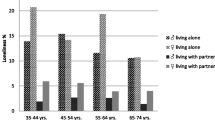Abstract
OBJECTIVE: To contrast sociodemographic characteristics, physical and mental health status, substance use, sexual behaviors, victimization, and utilization of health services between homeless women residing in sheltered and nonsheltered environments.
DESIGN: Cross-sectional survey. A structured scale was used to measure mental health status. Physical health status, substance use, sexual behavior, history of adult victimization, and health services utilization were measured by content-specific items.
SETTING: Shelters (N=47) and outdoor locations in Los Angeles.
PARTICIPANTS: One thousand fifty-one homeless women.
RESULTS: Homeless women living on the streets were more likely than sheltered women to be white and longer-term homeless. Controlling for sociodemographic characteristics, multiple logistic regression analyses revealed that unsheltered women had over 3 times greater odds of fair or poor physical health, and over 12 times greater odds of poor mental health than sheltered homeless women. They were also more likely than sheltered women to report using alcohol or noninjection drugs, to have multiple sexual partners, and to have a history of physical assault. About half of the overall sample reported utilization of a variety of health services; however, unsheltered homeless women were less likely to utilize all of the health services that were assessed, including drug treatment.
CONCLUSIONS: There is a critical need for aggressive outreach programs that provide mental health services and substance abuse treatment for homeless women on the streets. Comprehensive services that also include medical care, family planning, violence prevention, and behavioral risk reduction may be particularly valuable for homeless women, especially those living in unsheltered environments.
Similar content being viewed by others
References
Nyamathi A, Stein J. Assessing the impact of HIV risk reduction counseling in impoverished African-American women: a structural equations approach. AIDS Educ Prev. 1997;9:253–73.
Wenzel SL, Koegel P, Gelberg L. Access to substance abuse treatment for homeless women of reproductive age. J Psychoactive Drugs. 1996;28:17–30.
Gelberg L, Linn LS, Usatine RP, Smith MH. Health, homelessness, and poverty. A study of clinic users. Arch Intern Med. 1990;150:2325–30.
Zolopa A, Hahn J, Gorter R, et al. HIV and tuberculosis infection in San Francisco’s homeless adults. JAMA. 1994;272:455–61.
Fischer PJ. Alcohol and drug abuse and mental health problems among homeless persons: a review of the literature, 1980–1990. Rockville, Md: National Institute on Alcohol Abuse and Alcoholism and National Institute of Mental Health; 1990.
Gelberg L, Linn L. Assessing the physical health of homeless adults. JAMA. 1989;262:1973–9.
Ferenchick GS. Health and homelessness. Arch Intern Med. 1991;151:1462.
Gelberg L, Doblin BH, Leake B. Ambulatory health services provided to low-income and homeless adult patients in a major community health center. JGIM. 1996;11:156–62.
Nyamathi A, Keenan C, Bayley L. Differences in personal, cognitive, psychological, and social factors associated with drug and alcohol use and non-use by homeless women. Res Nurs Health. 1998;21:525–32.
Gelberg L, Linn LS. Social and physical health of homeless adults previously treated for mental health problems. Hosp Community Psychiatry. 1988;39:510–6.
Simpson DD. TCU Forms Manual. Ft. Worth, Tex: Institute of Behavioral Research, Texas Christian University; 1992.
Anglin MD, Longshore D, Turner S, McBride D, Inciardi J, Predergast M. Studies of the Functioning and Effectiveness of Treatment Alternatives to Street Crime (TASC) Programs. Los Angeles, Calif: UCLA Drug Abuse Research Center; 1996.
Dowling-Guyer S, Johnson ME, Fisher DG, et al. Reliability of drug users’ self-reported HIV risk behaviors and validity of self-reported recent drug use. Assessment. 1994;1:383.
Stewart AL, Hays RD, Ware JE Jr. The MOS short-form general health survey. Reliability and validity in a patient population. Med Care. 1988;26:724–35.
Aday LA. Designing and conducting health surveys. San Francisco, Calif: Jossey-Bass; 1991.
Ware JE, Sherbourne CD. The MOS 36-item short form health survey (SF-36). Med Care. 1992;30:473–83.
Berwick D, Murphy J, Goldman P, Ware J, Barsky A, Weinstein M. Performance of a five-item mental health screening test. Med Care. 1991;29:169–76.
Rubenstein LV, Calkins DR, Young RT, et al. Improving patient function: a randomized trial of functional disability screening. Ann Intern Med. 1989;111:836–42.
Gelberg L, Andersen R, Leake B. The behavioral model for vulnerable populations: application to medical care use and outcomes. Health Serv Res. In press.
U.S. Department of Health and Human Services. Healthy People 2000: National Health Promotion and Disease Prevention Objectives. Washington, DC: U.S. Department of Health and Human Services; 1990.
Buckner JC, Bassuk EL, Zima B. Mental health issues affecting homeless women: implications for intervention. Am J Orthopsychiatry. 1993;63:385–99.
Susser E, Moore R, Link B. Risk factors for homelessness. Epidemiology Rev. 1993;15:546–56.
Fisher B, Hovell M, Hofstetter CR, Hough R. Risks associated with long-term homelessness among women: battery, rape, and HIV infection. Int J Health Serv. 1995;25:351–69.
Zierler S, Krieger N. Reframing women’s risk: social inequalities and HIV infection. Ann Rev Public Health. 1997;18:401–36.
Henshaw SK. Unintended pregnancy in the United States. Fam Plann Perspect. 1998;30:24–9, 46.
Nyamathi A, Leake B, Keenan C, Gelberg L. Type of social support among homeless women: its impact on psychosocial resources, health and health behaviors, and health service utilization. Nurs Res. In press.
Whitbeck L, Simons R. Life on the streets: the victimization of runaway and homeless adolescents. Youth and Society. 1990;22:108–25.
Gelberg L, Linn L. Psychological distress among homeless adults. J Nerv Ment Dis. 1989;177:291–5.
Simon PA, Weber M, Ford WL, Cheng F, Kerndt PR. Reasons for HIV antibody test refusal in a heterosexual sexually transmitted disease clinic population. AIDS. 1996;10:1549–53.
Author information
Authors and Affiliations
Additional information
This research was supported by the National Institute on Drug Abuse, grants DA06719 and DA01070. Dr. Gelberg is a Robert Wood Johnson Generalist and Physician Faculty Scholar.
Rights and permissions
About this article
Cite this article
Nyamathi, A.M., Leake, B. & Gelberg, L. Sheltered versus nonsheltered homeless women. J GEN INTERN MED 15, 565–572 (2000). https://doi.org/10.1046/j.1525-1497.2000.07007.x
Issue Date:
DOI: https://doi.org/10.1046/j.1525-1497.2000.07007.x




